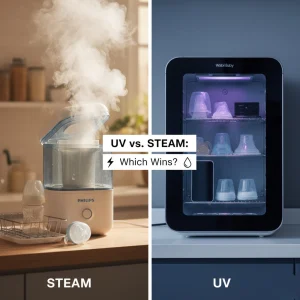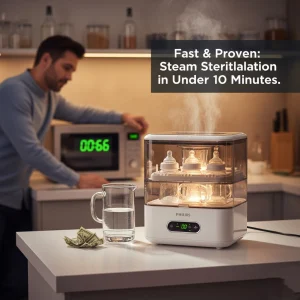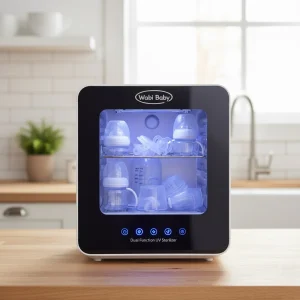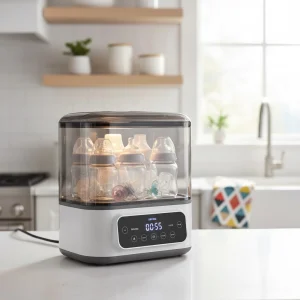Choosing between a UV sterilizer vs Steam sterilizer can feel like the ultimate parenting riddle. If you’ve ever searched “UV sterilizer vs steam sterilizer”, you’re not alone. Tons of parents do, and many of the articles you find skim the basics but leave you wondering which one fits your mess, your schedule, your sanity.

My goal here? To help you choose not just the “better tech,” but the one that actually helps you—because trust me, in the newborn phase, saving even 5 minutes feels like winning the lottery.
Both promise to banish 99.9% of harmful germs from baby bottles, pacifiers, and pump parts.
But which one is truly safer, faster, and more convenient for your family’s routine?
This guide will walk you through everything you need to know—pros, cons, expert tips, and our top picks.
Why Sterilization Matters for Baby Bottles
Newborns have fragile immune systems, making them more susceptible to bacteria, viruses, and fungi that can linger on bottles—even after a good scrub.
Pediatricians agree that sterilizing bottles during the first three to six months adds a vital extra layer of protection.
According to the American Academy of Pediatrics, proper sterilization:
- Kills up to 99.9% of germs that regular washing might miss.
- Reduces the risk of gastrointestinal infections.
- Provides peace of mind when traveling or when water quality is questionable.
In short, whether you choose UV or steam, the goal is the same—a cleaner, safer feeding experience.
What Is a Steam Sterilizer?

A steam sterilizer uses high-temperature steam (around 100°C / 212°F) to kill germs.
It’s a classic method trusted for decades and comes in two main types:
- Electric Countertop Steam Sterilizers
Self-contained units that plug into an outlet. Add water, load bottles, and press start.
Cycle Time: 5–15 minutes for sterilizing; some include drying cycles.
Popular Brands: Philips Avent, Baby Brezza, Papablic. - Microwave Steam Sterilizers
Lightweight trays or bags that go inside a microwave. Add a bit of water, heat for 2–8 minutes, and let steam work its magic.
Great for travel or small kitchens.
Steam Sterilizer Advantages
- Proven reliability – Hospitals have used steam for decades.
- Chemical-free – Just water and heat.
- Budget-friendly – Microwave bags can cost under $20.
- Fast cycles – Some electric models sterilize in as little as 5 minutes.
Steam Sterilizer Drawbacks
- Requires regular descaling to remove mineral buildup.
- Needs drying time unless you buy a combo sterilizer/dryer.
- Hard water can leave cloudy spots on bottles.
- Hot steam means you must wait for a cool-down before unloading.
What Is a UV Sterilizer?

A UV sterilizer uses UV-C light to destroy the DNA of bacteria, viruses, and mold—without water or heat.
It’s the newer tech in the baby market, inspired by medical equipment sanitizers.
How It Works
UV-C bulbs emit short-wavelength light that penetrates microorganisms, effectively inactivating them.
Fans circulate air to ensure even exposure, and many models include a gentle drying feature.
Types of UV Sterilizers
- Countertop Cabinets – Fit bottles, pacifiers, toys, and even phones.
- Portable Units – Small boxes or wands for travel or quick sterilizing.
UV Sterilizer Advantages
- No water, no heat – Perfect for hard-water homes.
- Low maintenance – No scaling or descaling.
- Drying + storage – Many models dry and keep bottles sterile for 24 hours.
- Gentle on plastics – No warping from high heat.
UV Sterilizer Drawbacks
- Higher upfront cost (typically $120–$300).
- Bulb replacement every 6–12 months.
- Some cycles take slightly longer (10–40 minutes, depending on load).
Side-by-Side Comparison: UV vs Steam
Here’s a no-fluff comparison so you can see what matters when you’re bleary-eyed and feeding a tiny human:
| Feature | UV Sterilizer | Steam Sterilizer |
| Cycle Speed | Usually 10–40 minutes (includes dry), depending on the model. | 5–15 minutes sterilizing; drying, separate or included in combo. |
| Drying & Storage | Commonly built-in or fan-forced air dry—often safe storage afterward. | Unless it has a drying function, you need drying racks or air dry to avoid the risk of moisture. |
| Material Stress | Gentler; less heat exposure; but UV may cause plastic yellowing over time. | High heat—plastics must be BPA-free and heat rated; repeated steam can warp or degrade some items. |
| Maintenance | Need to clean reflective surfaces; replace UV bulbs/LEDs eventually; less descaling. | Must descale if water is hard; clean the plate; dry parts fully to avoid mildew. |
| Cost (Upfront + Running) | Higher initial cost; running cost includes electricity and bulbs. | Lower initial cost for basic models; running cost includes water and occasional descaling. |
| Capacity & Fit | Some UV units are big; some are small. Curved objects may block light. | Steam spreads everywhere; molds around curve more reliably. |
| Safety | No scalding risk; risk if UV light leaks—good enclosed design essential. | Risk of burns from steam; water can spill; hot surfaces. |
When UV Wins (Scenarios Where You’ll Thank Yourself)
You might lean toward UV if:
- You live in a hard water area—steam models will require constant descaling, scale buildup, and frustrating cleanup.
- You sterilize a variety of items—not just bottles (pacifiers, toys, pump parts, maybe even small gadgets).
- You’re sensitive to heat or have fragile plastic parts that warp easily.
- You want to “set it and forget it”: push one button, and bottles are sterilized + dry + stored.
- You’re willing to invest a bit more upfront for long-term convenience.
When Steam Wins (Scenarios Where Steam Is Hard to Beat)
Steam may be better if:
- You want quick sterilization when you need bottles fast—in the middle of night chaos, fast switch-over matters.
- You have mostly durable heat-resistant items and don’t mind descaling.
- Your budget is tighter (steam-only models are typically cheaper).
- You value proven reliability and simplicity—steam has been around longer, and many parents trust the results.
What it Costs You Really Over Time
Let’s get honest: it’s not just “buy once. Need to spend more on:
- Bulb or LED replacements (for UV) — even the best models need parts replaced every ~1 year sometimes.
- Electricity usage: UV + drying fan may draw less heat but run longer; steam draws high power during heating.
- Descaling & maintenance: If you have to buy descaling agents regularly, or end up replacing items due to warping or yellowing, those costs add up.
- Durability of the bottles & accessories: Choosing materials that tolerate steam or UV well influences how often you need replacements.
Real Parent Stories
(Because We’re All in This Sleep-Deprived Together)
“I have a UV sterilizer I used at the start… I never noticed yellowing. The ease of just pressing a button during midnight feeding is a lifesaver.” — Redditor parent Reddit
“We got a Wabi steam sterilizer and dryer… still works great after daily use. But for delicate pump parts, I keep a UV box because steam warps the flanges.” — Another parent, Reddit
These aren’t marketing blurbs—they’re real wins (and sometimes regrets). Insight: mixing both or choosing combo appliances helps.
Safety, Maintenance & Things You Must Know
- Always wash with soap first. Neither UV nor steam cleans dirt residue—sterilizes what’s already clean.
- Ensure materials are compatible: BPA-free, heat-rated for steam; UV-safe plastics to avoid degradation.
- For UV bulbs, check the manufacturer’s specifications for wavelength (you want true UV-C) and a safe enclosure to prevent light leakage.
- Keep UV interiors clean; reflectors matter.
- Steam: empty the water pan after each cycle, avoid leaving water sitting; dry all parts to stop mold.
- Check cords, seals, and door closures; small leaks or gaps make sterilizers less effective.
Wondering when you can finally relax on sterilizing? Our guide on how often to sterilize bottles breaks it down by baby’s age with easy, no-stress tips.
Quick Takeaway:
Steam wins for speed and affordability, while UV shines for low maintenance and gentle drying.
Key Buying Considerations
When choosing between UV and steam, keep these factors in mind:
- Bottle Type & Capacity – Wide-neck bottles, such as Dr. Brown’s, require a spacious chamber.
- Budget vs Convenience – Steam is cheaper; UV is pricier but easier to maintain.
- Home Environment – Hard water? UV saves you from descaling headaches.
- Frequency of Use – Newborns = multiple sterilizations per day. Steam’s quick cycles may be a lifesaver.
- Travel Needs – Microwave steam bags are unbeatable for portability, but UV wands work well for hotel stays.
UV Sterilizer vs. Steam Sterilizer,
Which One Fits Your Life?
Choose Steam If:
- You need speed for late-night feeds
- You want a budget-friendly solution
- You like simple, proven technology
Choose UV If:
- You have hard water or hate descaling
- You want drying + 24-hour sterile storage
- You need to sterilize toys, pump parts, or phones
Can’t decide? Some high-end models combine steam + drying + UV, giving you the best of both worlds.
Top Picks
Here are the best models in each category, tested and loved by parents:

Best UV Sterilizers
- Wabi Baby Touch Panel Dual Function UV – Quiet fan drying, HEPA filter, and sleek touch controls.
- Munchkin 59S Portable UV – Fits in a diaper bag for on-the-go pacifier emergencies.
Best Steam Sterilizers

- Baby Brezza One Step Sterilizer & Dryer Advanced – Sterilizes and dries up to 8 bottles in 60 minutes with HEPA-filtered air.
- Philips Avent 4-in-1 Electric Steam Sterilizer – Modular racks, 6-bottle capacity, and a quick 6-minute sterilization cycle.Curious if the hype is real? Read our in-depth Philips Avent sterilizer review to see why it’s a long-time favorite for parents who want speed and reliability.
Expert & Parent Opinions on
UV Sterilizer vs. Steam Sterilizer
“Both UV and steam sterilizers kill 99.9% of harmful bacteria when used correctly.
The choice often comes down to convenience and household water quality.”
— Dr. Natalie Tarrant, FAAP
Parents echo the sentiment:
“I switched to UV because of our hard water. No more scrubbing mineral deposits!” — Emily R., mom of two.
“Steam is faster, and I love that it’s just water—no extra parts to replace.” — David L., first-time dad.
Cleaning & Maintenance Tips
- Steam Sterilizers – Empty leftover water after every cycle. Descale weekly with vinegar to prevent buildup.
- UV Sterilizers – Wipe interior weekly with a dry cloth. Replace UV bulbs or filters every 6–12 months for optimal performance.
- Always wash bottles with soap and water before sterilizing—neither method removes milk residue.
Final Verdict: Which Sterilizer Wins?
The battle of UV sterilizer vs steam sterilizer isn’t about which is “better.”
It’s about which fits your routine—and saves you time when every minute matters.
- Need fast, affordable, proven? → Steam.
- Want hands-off drying and hard-water freedom? → UV.
Either way, you’ll feed your baby with bottles that are clean, safe, and ready whenever hunger strikes.
And that peace of mind? Totally priceless.
FAQs
Q1. Is UV sterilization safe for baby bottles?
Yes. Reputable brands use baby-safe UV-C light levels and BPA-free interiors.
Q2. Does a UV sterilizer kill more germs than steam?
Both kill 99.9% of common bacteria and viruses when used correctly.
The difference lies in method, not effectiveness.
Q3. Do I still need to wash bottles before sterilizing?
Absolutely. Sterilizers kill germs but don’t remove milk residue.
Q4. How often should I sterilize bottles?
For newborns: daily or after every use. For older babies: a few times per week is usually enough.
Q5. Can steam or UV damage plastic bottles?
Steam can warp non–BPA-free plastics if overheated. UV is gentler but follow manufacturer guidelines.
Q6. Which method is better for traveling?
Microwave steam bags are the most portable, but compact UV boxes are great for hotel stays or airplanes.